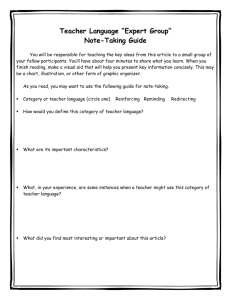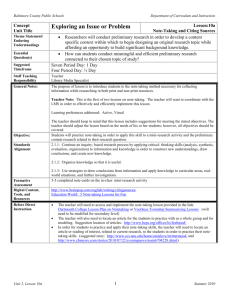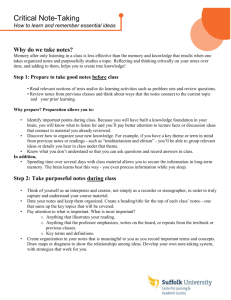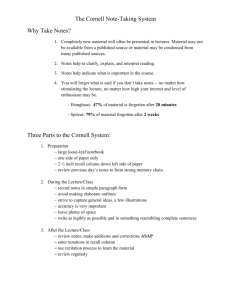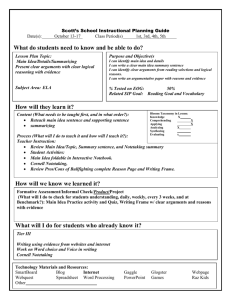Educational and Career Counseling Center Starr 313
advertisement
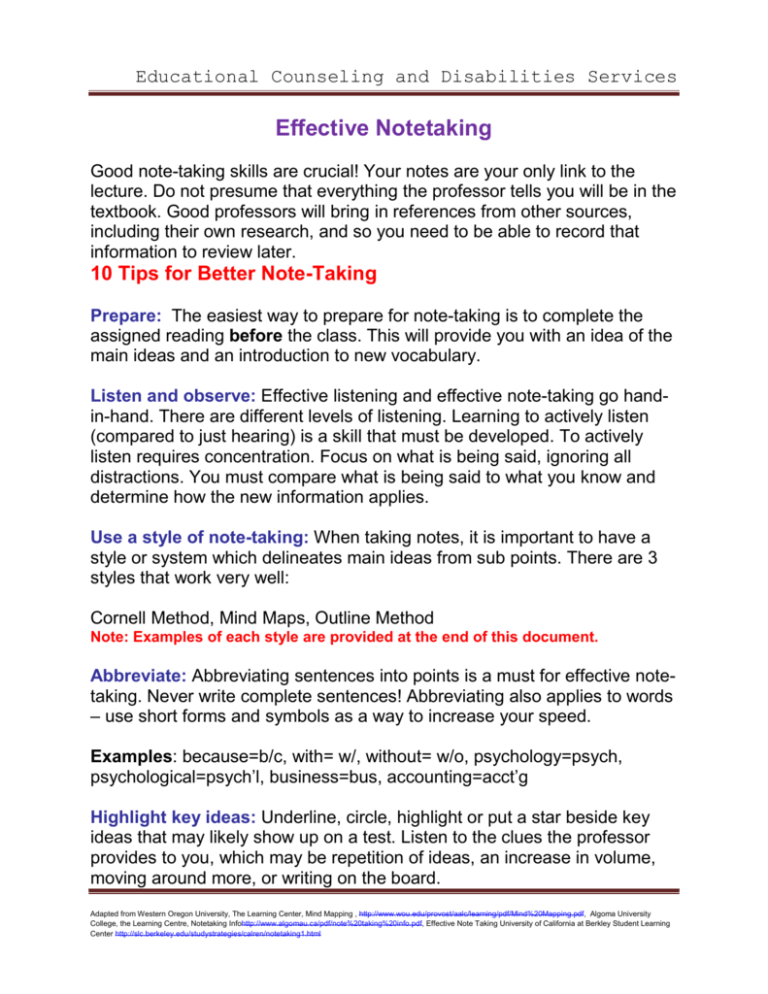
Educational Counseling and Disabilities Services Effective Notetaking Good note-taking skills are crucial! Your notes are your only link to the lecture. Do not presume that everything the professor tells you will be in the textbook. Good professors will bring in references from other sources, including their own research, and so you need to be able to record that information to review later. 10 Tips for Better Note-Taking Prepare: The easiest way to prepare for note-taking is to complete the assigned reading before the class. This will provide you with an idea of the main ideas and an introduction to new vocabulary. Listen and observe: Effective listening and effective note-taking go handin-hand. There are different levels of listening. Learning to actively listen (compared to just hearing) is a skill that must be developed. To actively listen requires concentration. Focus on what is being said, ignoring all distractions. You must compare what is being said to what you know and determine how the new information applies. Use a style of note-taking: When taking notes, it is important to have a style or system which delineates main ideas from sub points. There are 3 styles that work very well: Cornell Method, Mind Maps, Outline Method Note: Examples of each style are provided at the end of this document. Abbreviate: Abbreviating sentences into points is a must for effective notetaking. Never write complete sentences! Abbreviating also applies to words – use short forms and symbols as a way to increase your speed. Examples: because=b/c, with= w/, without= w/o, psychology=psych, psychological=psych’l, business=bus, accounting=acct’g Highlight key ideas: Underline, circle, highlight or put a star beside key ideas that may likely show up on a test. Listen to the clues the professor provides to you, which may be repetition of ideas, an increase in volume, moving around more, or writing on the board. Adapted from Western Oregon University, The Learning Center, Mind Mapping , http://www.wou.edu/provost/aalc/learning/pdf/Mind%20Mapping.pdf, Algoma University College, the Learning Centre, Notetaking Infohttp://www.algomau.ca/pdf/note%20taking%20info.pdf, Effective Note Taking University of California at Berkley Student Learning Center http://slc.berkeley.edu/studystrategies/calren/notetaking1.html Leave lots of space: Note-taking is not a time to be concerned about conserving paper. Leave space in between ideas so that extra notes, examples, etc, can be added after. If you feel that you missed what the professor was saying, leave lots of space and fill it in later from the textbook or a classmate’s notes. Mark ideas that require more information or clarification: If there are some things that you do not understand, put a question mark beside the point, leave some space and go back to it later. Ask the professor after class, ask a classmate or turn to the textbook. You could also try searching on the Internet for additional information that may be explained in a different way that makes more sense to you. Ask questions: Become actively involved in the lecture. Listen closely and ask yourself questions about the material. How does this information relate to something you already know? How does it relate to the course? Don’t be afraid to ask questions in class and become involved in discussions. Be an active participant! Revise your notes: Revising your notes does not mean simply copying them to make them neater. It means summarizing, paraphrasing, linking ideas and condensing to create study notes. Pay attention to possible test questions – think like a prof! Review notes at least twice a week: Taking the time to review all your class notes (from beginning of the semester) will save you a HUGE amount of time when it comes time to study for the test or exam. If you don’t regularly review, you will have to basically re-learn everything. Without regular review, almost all the information will be forgotten by just 24 hours after the lecture! Adapted from Western Oregon University, The Learning Center, Mind Mapping , http://www.wou.edu/provost/aalc/learning/pdf/Mind%20Mapping.pdf, Algoma University College, the Learning Centre, Notetaking Infohttp://www.algomau.ca/pdf/note%20taking%20info.pdf, Effective Note Taking University of California at Berkley Student Learning Center http://slc.berkeley.edu/studystrategies/calren/notetaking1.html Example of Cornell System of Note-Taking MAIN IDEAS: SUPPORTING IDEAS/DETAILS and EXAMPLES: Divide Paper into Columns Use the front side of your paper (loose-leaf is easiest to use). Draw a margin 2-3 inches from the left side. Use areas to the right of the line and take notes in your typical style – one that works for you. Use indentations or bullets or arrows for lines having the same ideas, as in paragraphs. Indicate when you change ideas Listening and Writing Skip a line or two to indicate change of ideas. Listen carefully to the lecture. Note only the most important points briefly. Do not stop listening. Don’t try to write everything down. Use abbreviations, or any shortcuts that will help get the information down quickly. Write in words you understand, not necessarily the lecturers unless they are vocabulary words you need to know for exams. Completing Notes with Clues After you finish the notes on the right side of the line, go back over your notes before they get “cold”, reading and deciding on major points. You can also add notes from your reading to help clarify ideas. Place clues or labels from the notes on the left side of the margin. Highlight those ideas that are important. Studying for Test from Notes When you study your notes, cover the material on the right and attempt to recall important details only from the clues or labels on the left. If you can’t, peek at the notes on the right and try again. SUMMARY, QUESTIONS, ADDITIONAL NOTES Summarize lecture at bottom of the page in your own words. Adapted from Western Oregon University, The Learning Center, Mind Mapping , http://www.wou.edu/provost/aalc/learning/pdf/Mind%20Mapping.pdf, Algoma University College, the Learning Centre, Notetaking Infohttp://www.algomau.ca/pdf/note%20taking%20info.pdf, Effective Note Taking University of California at Berkley Student Learning Center http://slc.berkeley.edu/studystrategies/calren/notetaking1.html Links Example of Mind Mapping System of Note-Taking Use at Least 3 Different Colors Colors USE Always Start in the Middle of Your Paper CENTER Emphasis Images Dimension Mind Mapping Basics AKA Doodling with a Purpose Codes Outlines: A 1 2 B Doodle/Draw Images of Topic Personalize STYLE CLARITY Thicker – more important Hierarchy UPPER and lower Case Central Develop Order, 1,2,3 Same length Style Free Flow Organic For Each word, image, alone Start in Center Print Organized Outer Lines Thinner – less important KEYWORDS Radiate Out Connect Adapted from Western Oregon University, The Learning Center, Mind Mapping , http://www.wou.edu/provost/aalc/learning/pdf/Mind%20Mapping.pdf, Algoma University College, the Learning Centre, Notetaking Infohttp://www.algomau.ca/pdf/note%20taking%20info.pdf, Effective Note Taking University of California at Berkley Student Learning Center http://slc.berkeley.edu/studystrategies/calren/notetaking1.html Example of Outline System of Note-Taking I. Structure and Organization of Note Outlines. Each student should develop his/her own method of taking notes; however, the following suggestions may be helpful. A. Keep a separate section of your notebook or binder for each course. If there are several types of notes for one course, such as lecture notes, notes on outside readings, and computation of problems, you may want to arrange them on opposite pages for purposes of cross-reference B. Notes for each lecture should begin on a new page. This makes for a greater legibility and allows for more freedom in organization C. Date your lecture notes and number all pages. D. Make your notes brief. 1. Never use a sentence when you can use a phrase, or a phrase when you can use a word. 2. Use abbreviations and symbols wherever possible E. Put most notes in your own words. However, the following should be noted exactly: 1. Formulae 2. Definitions 3. Specific facts F. Note your lecturer's chief pattern. S/he may be summarizing the text and highlighting important points, or trying to draw relationships between new and previous understandings. S/he may expect you to get the textbook material on your own while he discusses related outside material. 1. If s/he is highlighting the text, take down explanations and examples. 2. Seeing a concept stated in more than one way can help you understand it. G. If s/he draws relationships and asks questions, note the questions and answers. If s/he doesn't give the answers, try to find them after class. H. Don't worry about outlining, but use indentations to distinguish between major and minor points. Numbers and letters may be added later if you wish. I. However, if the lecturer says s/he will make four or five points, list four or five causes, etc., be sure to use numbers as a check on having taken them all down. J. Note down unfamiliar vocabulary and unclear areas. If the lecturer discusses something you don't understand, take it down as best and as completely as you can. Then you can check with the text or at least know what questions to ask if Adapted from Western Oregon University, The Learning Center, Mind Mapping , http://www.wou.edu/provost/aalc/learning/pdf/Mind%20Mapping.pdf, Algoma University College, the Learning Centre, Notetaking Infohttp://www.algomau.ca/pdf/note%20taking%20info.pdf, Effective Note Taking University of California at Berkley Student Learning Center http://slc.berkeley.edu/studystrategies/calren/notetaking1.html getting help from someone else. If your instructor knows just what you don't understand, s/he's in a position to help you. K. If you should miss something completely, leave a blank space and get it later. L. Use margins for questions, comments, notes to yourself on unclear material, etc. M. Develop a code system of note-marking to indicate questions, comments, important points, due dates of assignments, etc. This helps separate extraneous material from the body of notes and also helps point out areas which are unclear. Margins are excellent places for coded notations. Some suggested codes are: 1. ? - not clear at time of lecture 2. Imp. or ! – important 3. Q – questions 4. * - assignment 5. C - comment(student's own) N. Attempt to differentiate fact from opinion. II. Content. A. Notes should include all main ideas and enough subordinate points to clarify understanding. B. All formulae, rules, definitions, and generalizations should be included. C. Inclusion of the speaker's illustrations and examples may help clarify concepts when notes are reviewed. D. Marginal notes facilitate speedy location of specific items. E. Instructors usually give clues as to what is important to take down: 1. previews and summaries 2. material written on blackboard, other visual aids 3. repetition 4. vocal emphasis 5. questions asked of the class word clues: four causes of; four aspects of; therefore; in conclusion; and so we see; hence; in a like manner; on the other hand; however; cause-effect; relationships; etc. Contact ecds@ferris.edu for assistance. Adapted from Western Oregon University, The Learning Center, Mind Mapping , http://www.wou.edu/provost/aalc/learning/pdf/Mind%20Mapping.pdf, Algoma University College, the Learning Centre, Notetaking Infohttp://www.algomau.ca/pdf/note%20taking%20info.pdf, Effective Note Taking University of California at Berkley Student Learning Center http://slc.berkeley.edu/studystrategies/calren/notetaking1.html
